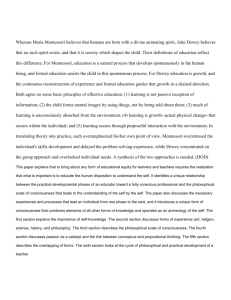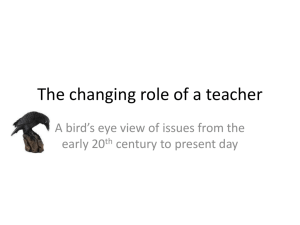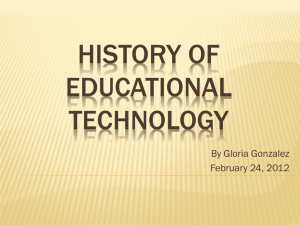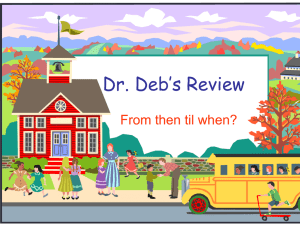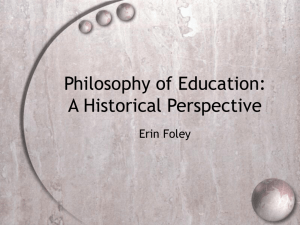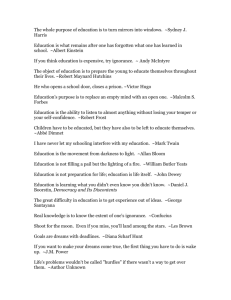Me as an Educator
advertisement
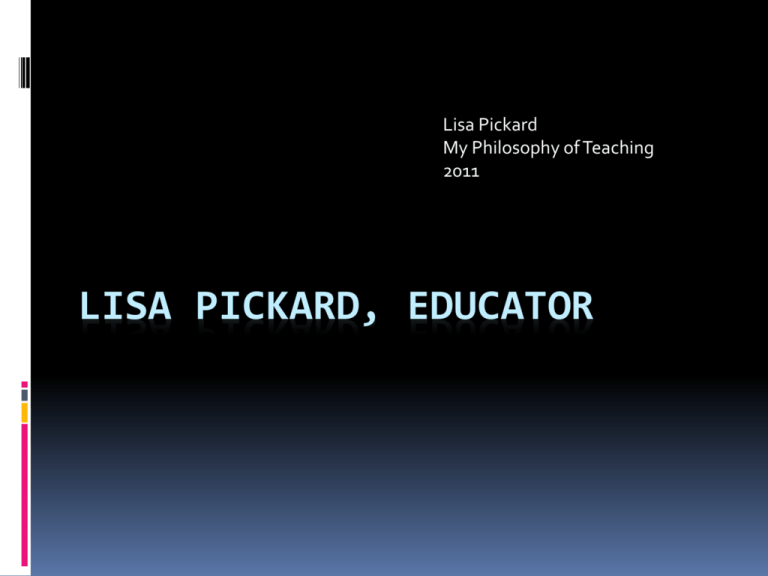
Lisa Pickard My Philosophy of Teaching 2011 LISA PICKARD, EDUCATOR LISA PICKARD Mother Mentor Friend LISA PICKARD Educator Family Advocate Student “Light the Night Walk “ Team Alexandra Life- Long Commitment to PreCollege College Education Niagara University Hilbert Erie Community Elementary College Buffalo High School Middle University of M.S Ed. Early Childhood and Childhood B.S. John A. Sciole Lancaster High School Aurora Middle School A.A.S. Criminal Justice Criminal Justice Education B.A Birth-6 Psychology “Education is not preparation for life: Education is Life Itself” -John Dewey (Pioneers, n.d.) The Pragmatist in ME The Existentialist in Me: Students do have to make personal choices about their future. Students do have free will. One should reflect and take the time to figure out who they are currently and decide who they want to become. “Each person has the potential for loving, creating, and being” (Ornstein and Levine, 2008, p 174). Pragmatist Instruction stresses the process of learning as problem-solving. Importance of interaction between student and the environment . The environment is constantly changing Truth is mutable. Reality and Truth is based on Experience. The Realist in ME Me Existentialist Realist Students construct theories of the world around them and use the Scientific Method to test those theories. Students know because they use their senses to gather data, sort data, form concepts, and test. Curriculum is presented systematically. Organized into subjects. Logic can be both deductive and inductive. I agree with the theory of progressivism on education, in that, students should be active and learn to solve problems, then reflect on their findings. Society is ever-changing, Education needs to change with it. Focus on the child. Promote and build on their interests BUT strike a balance between their interests and the new core curriculum (as in the Essentialism Theory on Education). Children at the Elementary Education level need to be presented the essential knowledge and skills as a starting point to their education. Everyone needs a basic foundation from which to build their interests. How can a child possibly know what interests them if they do not know what exists? Through hard-work, discipline, and a strong knowledge base they can begin to construct their own ideas, test them, and draw conclusions-- and then decide what interests them. Progressivism ME Essentialism Montessori: Early Childhood Development-I believe is best for birth to 5 years old. Adapt child’s environment to his or her needs. Activities are modeled, demonstrated, and then children are allowed to explore with self-directed learning. Teacher is the guide. This assists a child’s sensory, muscular, and intellectual development. Emphasis on a prepared environment to facilitate physical activity. www.montessori.org The Pioneers Who Inspire Me Montessori Dewey Montessori Dewey Dewey: Childhood Development through Elementary School and on.. Children are social, active human beings ready to explore and gain control of their environment. Through interaction with the world children solve problems by using the scientific-method. Children learn how to think reflectively which leads to personal and intellectual growth. Knowledge is continually changing. Education and Life are interrelated, not separate entities. Children learn best by hands-on learning, experiential education. Supports multicultural education. www.johndewey.org Addams Addams: Elementary Education and continuing. Supports Multicultural Education. Schools restore a sense of community. Socialization and education of the child. The bridge between a child’s immediate environment and the society as a whole. Encourages strong family support. Children explore environment www.hullhouse.org I agree with Dewey that there needs to be a balance between subject matter and students interests and needs. At the Elementary level, students need more guidance and instruction than they do at the Intermediate levels. I believe that there should be structure to the instruction and curriculum but I also believe that you must allow students the freedom to explore within each lesson. Student Centered Teacher Centered Lesson plans are constructed using a Backwards Design Planning Model. Lesson plans include: a specific objective, NYS Core Standards, preparation and prior knowledge pre-requisites, a clear set of steps outlining what is to be taught beginning with an anticipatory set (to motivate and engage), accommodations for all students with exceptionalities , remedial and enrichment plans, closure, and proper assessments. Using multiple teaching models, strategies, and a constructivist approach to education students will explore, interact socially, discover and construct knowledge based on experiences and prior knowledge. Utilize a balance of Direct Instruction, Presentation and Explaining, Concept Teaching, Cooperative Learning, ProblemBased Learning, and Classroom Discussion. Various grouping methods for instruction and task completion will include: Whole Group, Small Group, Partner, and Individual groups Assessment Instruction Planning Purposefully planned lessons and activities with clearly described goals and objectives to motivate and engage students. Ensuring that all unit and lesson plans are constructed to meet the NYS Common Core Standards and Policies set forth by the school district. Assessment should be simple to implement and deep for sustainability and should involve teachers, students, parents, and administrators. Eight Big Ideas of Assessment (1) Assessment serves different purposes: diagnostic, formative, and summative (2) Assessment must be planned and purposeful both informal and formal (3) Assessment must consist of a range of types including oral, performance and written tasks (4) Assessment and Instruction must exist together, as assessment informs learning (5) Students learn best when assessment results are given in words, so they know what they did well, what they have done poorly, and what they must do to improve (6) Assessment is a collaborative process (7) Performance Standards are essential for effective assessment (8) Professional Judgment is needed when reporting and grading student achievement Collect sufficient sample of work and data through use of Portfolios, exams, standard tests, oral and other written communications Cooper,D.(2006). Talk About Assessment, Thomson and Nelson, Toronto, CA, p 4-5. Utilize the Principle of Least Intervention. Mutual respect. Positive Reinforcement. Establish Clear Classroom Rules, Procedures, and Expectations that govern movement, talking, time management, and behaviors appropriate throughout daily activities. Take the necessary time to explicitly teach and ensure each student is clear on these policies. Set up an effective learning environment that encourages inquiry, exploration, discovery, and cooperative learning. Engage learners. Successful management sets students up for success in future grades. Purposefully Plan Enforcement of rules and procedures must be swift, fair, and consistent. It must take into account a students age, cognitive, and socio-emotional development. Students are INTRINSICALLY motivated to learn. CLASSROOM MOTIVATION Use extrinsically motivators less and less as intrinsic motivators take hold. Building a community of life-long learners. Success breeds further learning. Excitement grows as students want to be their personal best. SUCCESS Students begin to learn when their basic needs are met. Encourage students to express themselves. Students feel valued. Once students are comfortable they begin to learn, understand, and grow as individuals.. Use praise and encouragement for positive behaviors. The environment is fun and exciting. Utilize and Understand Abraham Maslow’s Hierarchy of Needs . Take the time to KNOW your students- personal life, academic strengths and weaknesses, likes/dislikes, learning styles. KNOW your students familybackground, culture, beliefs , parental support and involvement. Be genuine. Show respect, love, convey belonging, interest in personal and academic life and growth. Provide safe, secure environment conducive to learning Slavin, R. E. (2009). Educational Psychology: Theory and Practice with MyEducationLab (9th Edition) (MyEducationLab Series) (9 ed.). Columbus, OH: Pearson. Opposing Multicultural Education IS NOT AN OPTION Teachers help students to grow to become independent selfregulated life-long learners Impart knowledge and empower students to construct new knowledge Prepare students for a successful future, contributing to a global society Build self-esteem and confidence Promote teamwork, friendships, peer culture Provide the safe, nurturing place for students to learn and grow What do I want my Class to Look Like? My Class Not my Class students.umf.maine.edu http://www.jigsawcreche.ie/ images/Original%20Files/m ontessori-room.jpg http://www.franklin.ma.us/auto/upload /schools/oak/704-classroom-010.jpg http://imagecache5.art.com/p/LRG/27/2759/IE4TD00Z/alfredeisenstaedt-elementary-school-children-with-heads-down-on-deskduring-rest-period-in-classroom.jpg Elementary Educator Continuing Education in Literacy and School Administration On-Going Professional Development to develop computer skills to integrate the latest technology into the classroom References Ornstein, A. & Levine, D. (2008). Foundations of Education. Boston: Houghton Mifflin. Pioneers In Our Field: John Dewey - Father of Pragmatism | Scholastic.com. (n.d.). Teaching Resources, Children's Book Recommendations, and Student Activities | Scholastic.com. Retrieved November 23, 2009, from http://content.scholastic.com/browse/article.jsp?id=3424

